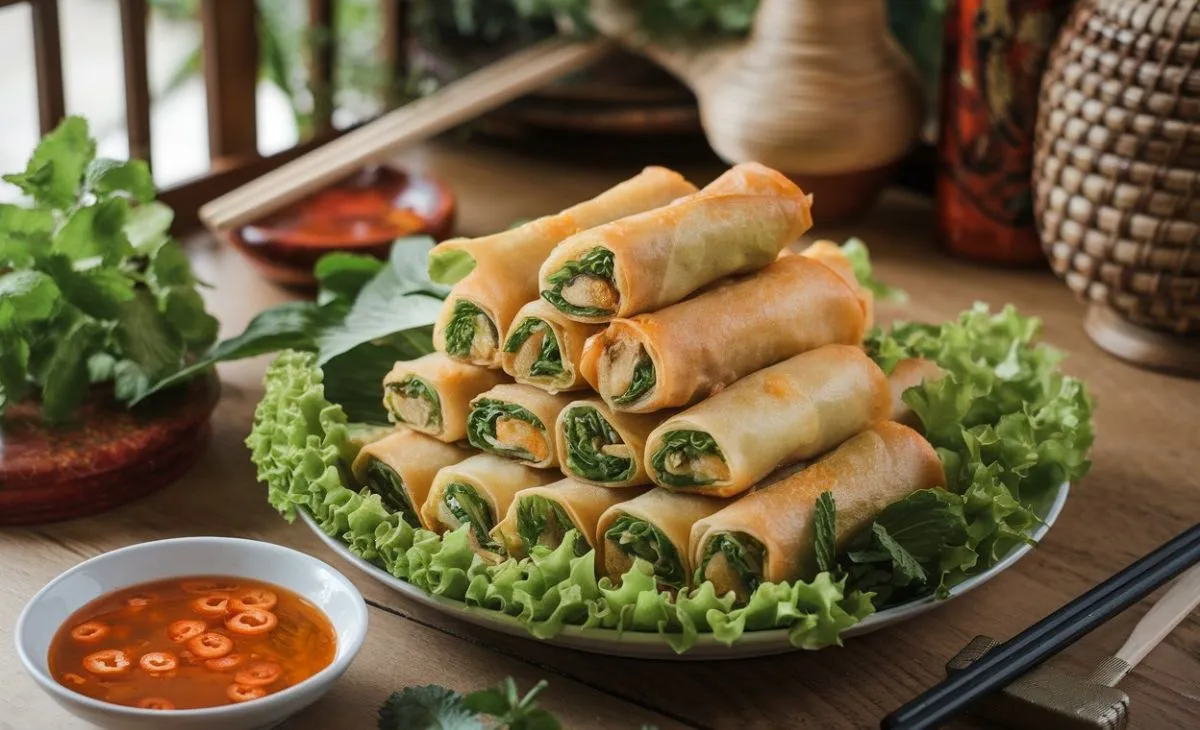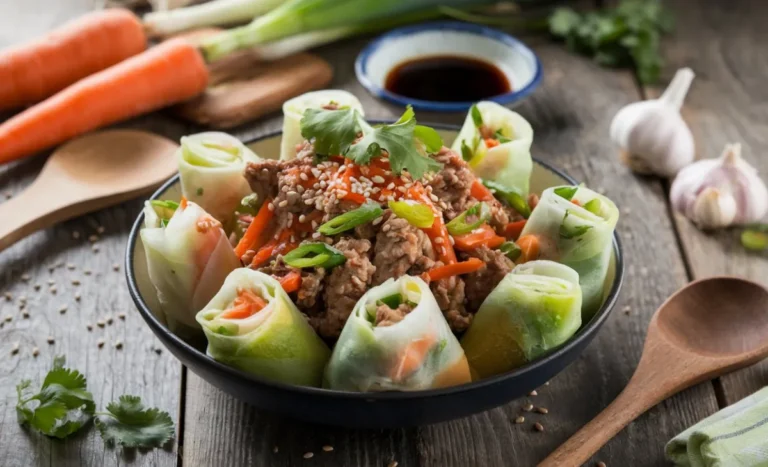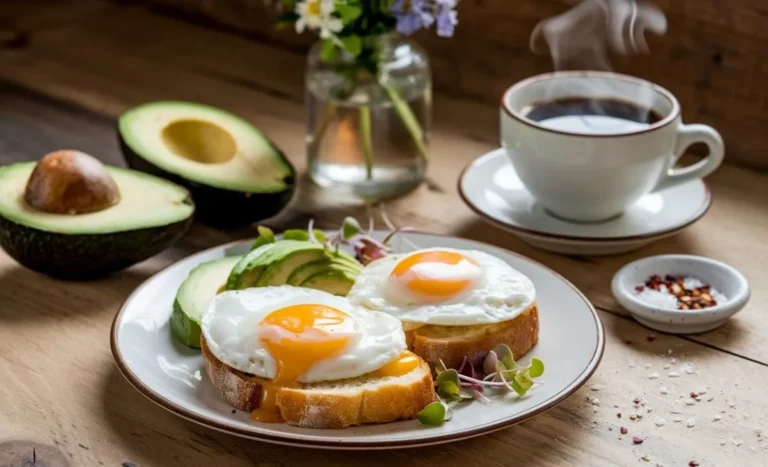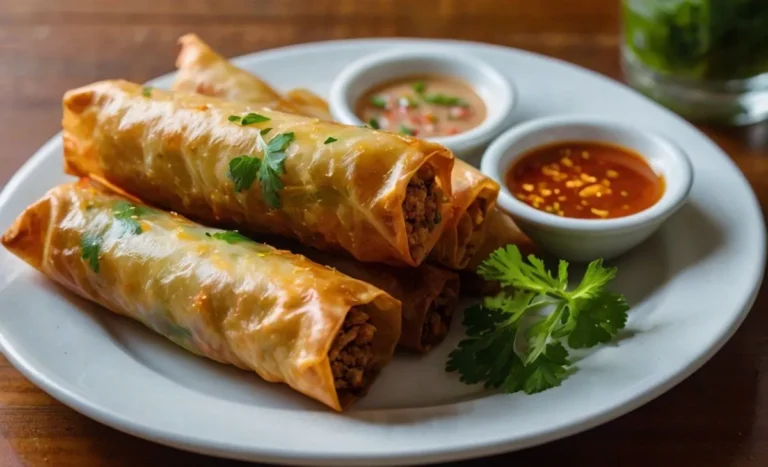The Best Vietnamese Egg Roll Recipe: Tips for Perfecting This Classic Dish
Introduction to Vietnamese Egg Rolls
Vietnamese egg rolls, known as chả giò, are a beloved staple in Vietnamese cuisine. This dish showcases a perfect combination of flavors and textures, making it a popular choice for many. In this article, we will explore an authentic Vietnamese egg roll recipe, highlighting tips to perfect this classic dish. These crispy rolls offer a delightful crunch that pairs beautifully with a variety of dipping sauces.
Traditionally, Vietnamese egg rolls are made with rice paper wrappers and a savory filling, often containing a mix of proteins and vegetables. Ground pork and shrimp are popular choices, adding rich flavor and a satisfying bite. Fresh herbs, carrots, and mushrooms can also enhance the filling, making each roll unique. When preparing this Vietnamese egg roll recipe, focus on high-quality ingredients to ensure the best results.
The cooking process may seem intimidating, but mastering this dish is simpler than it appears. Rolling and frying techniques play a crucial role in achieving the perfect texture. As you follow the steps outlined in this guide, you will gain confidence in your cooking skills. Consequently, you’ll be able to impress family and friends with your delicious homemade egg rolls.
In conclusion, this Vietnamese egg roll recipe is not just about food; it embodies tradition and culture. These rolls are often served during celebrations, family gatherings, or as appetizers at gatherings. By learning how to create this classic dish, you will not only enjoy a tasty treat but also connect with Vietnamese culinary heritage. Let’s dive into the ingredients and techniques that will help you perfect your egg roll-making skills!
Key Ingredients for Vietnamese Egg Rolls
To create an authentic Vietnamese egg roll recipe, the choice of ingredients is vital. Each component contributes unique flavors and textures, making your egg rolls truly memorable. Typically, the filling includes a combination of proteins, vegetables, and spices that enhance the overall taste. By selecting fresh, high-quality ingredients, you will elevate your dish and impress your guests.
One of the primary ingredients in Vietnamese egg rolls is ground pork. This meat offers a rich, savory flavor that forms the base of the filling. Additionally, shrimp adds a delightful sweetness and a satisfying texture. Using a combination of these proteins creates a well-rounded filling that appeals to many palates. Don’t forget to finely chop or mince your ingredients to ensure they blend seamlessly in each roll.
Vegetables play a crucial role in adding freshness and crunch to the filling. Common choices include carrots, cabbage, and mushrooms. Carrots bring a slight sweetness and vibrant color, while cabbage adds a satisfying crunch. Mushrooms, on the other hand, provide an earthy flavor that complements the other ingredients. Incorporating these vegetables not only enhances the taste but also increases the nutritional value of your Vietnamese egg roll recipe.
Finally, seasonings and herbs are essential for achieving the perfect flavor profile. Ingredients like garlic, green onions, and fish sauce can add depth and complexity to your filling. Fish sauce provides an umami kick, while fresh herbs like cilantro and mint add brightness. By carefully selecting and balancing these key ingredients, you’ll create a delicious Vietnamese egg roll recipe that showcases the vibrant flavors of Vietnamese cuisine.
Step-by-Step Guide to Making the Filling
When it comes to crafting the perfect Vietnamese egg roll recipe, the filling is where the magic happens. A flavorful filling makes all the difference in achieving that authentic taste. In this step-by-step guide, you will learn how to prepare a delicious and satisfying filling that will impress your family and friends. Let’s dive in and create the ideal mixture for your egg rolls!
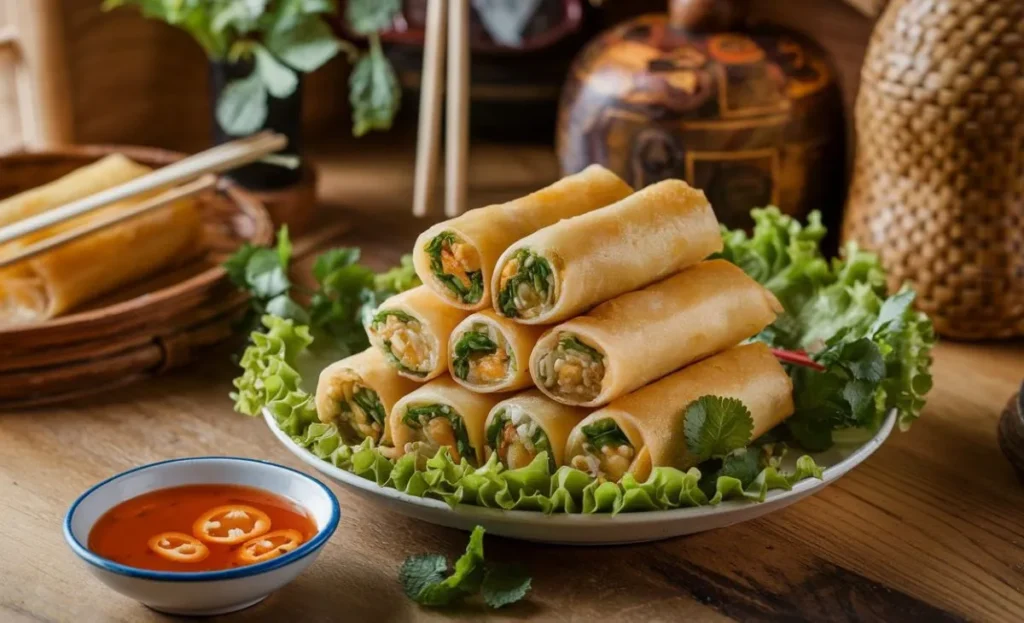
Ingredients:
- 1 pound ground pork
- 1/2 pound shrimp, peeled and deveined
- 1 cup finely shredded cabbage
- 1/2 cup grated carrots
- 1/4 cup mushrooms, finely chopped
- 2 green onions, finely chopped
- 3 cloves garlic, minced
- 2 tablespoons fish sauce
- 1 teaspoon sugar
- Salt and pepper to taste
- 1 tablespoon sesame oil
Step-by-Step Instructions:
- Prepare the Shrimp: Start by chopping the shrimp into small pieces. You can use a knife or a food processor for this step. Ensure the shrimp are finely minced to distribute the flavor evenly throughout the filling.
- Combine the Ingredients: In a large mixing bowl, combine the ground pork, minced shrimp, shredded cabbage, grated carrots, chopped mushrooms, and green onions. Mix well to ensure all the ingredients are evenly distributed.
- Add Seasonings: Next, add minced garlic, fish sauce, sugar, salt, and pepper to the mixture. Stir everything together until fully combined. The fish sauce adds an authentic depth of flavor, while the sugar balances the savory elements. ️
- Incorporate the Oil: Finally, drizzle in the sesame oil and mix once more. This oil will enhance the richness of the filling and contribute to its overall flavor. Your filling is now ready!
By following these steps, you’ll create a delicious filling that perfectly complements your Vietnamese egg roll recipe. Now that you have the filling prepared, you’re one step closer to enjoying these tasty treats!
Techniques for Rolling and Wrapping Egg Rolls
To achieve the perfect Vietnamese egg roll recipe, mastering the rolling and wrapping techniques is essential. Properly rolling your egg rolls ensures they stay intact during frying, resulting in a crispy, golden exterior. Additionally, well-wrapped egg rolls prevent the filling from spilling out, allowing you to enjoy every bite. In this guide, we’ll explore effective techniques that will help you wrap your egg rolls like a pro!
Start by preparing your work area. Lay out a clean, flat surface and place a small bowl of water nearby. You’ll also need your egg roll wrappers ready for use. When you’re ready to roll, take one wrapper and place it on your surface in a diamond shape, with one corner pointing toward you. This orientation allows for a better fold as you begin to wrap your egg rolls.
Next, spoon about 2 tablespoons of the prepared filling onto the center of the wrapper. Be careful not to overfill, as this can make rolling difficult. Once you have added the filling, fold the bottom corner over the filling. Then, gently press the filling to shape it into a log. This step is crucial, as it helps to compact the filling and create a tight roll.
After folding the bottom corner, continue rolling the wrapper away from you, folding in the sides as you go. Use a little water on the edges of the wrapper to seal it. This moisture creates a sticky surface that holds the egg roll together. Finally, press the seams gently to ensure they are sealed securely. With practice, you’ll master these techniques, resulting in beautifully wrapped egg rolls ready for frying!
Frying Methods for Crispy Perfection
Frying plays a crucial role in achieving crispy perfection for your Vietnamese egg roll recipe. The right frying method can elevate the texture and flavor, making each bite a delightful experience. With just a few tips and techniques, you can ensure that your egg rolls turn out perfectly golden and crispy every time. Let’s explore the best frying methods to achieve that restaurant-quality crunch!
First, choose the right oil for frying. A high smoke point oil, such as vegetable, canola, or peanut oil, is ideal for deep frying. These oils can withstand high temperatures without burning, which is essential for achieving the perfect crisp. Next, heat the oil in a deep pot or wok to around 350°F (175°C). Using a thermometer can help maintain the right temperature, ensuring your egg rolls cook evenly and thoroughly.
Once the oil is hot, carefully add a few egg rolls at a time. Avoid overcrowding the pan, as this can lower the oil temperature and result in soggy rolls. Fry the egg rolls for about 4-5 minutes, turning occasionally, until they achieve a golden-brown color. This step is vital, as frying them at the correct temperature ensures that the filling cooks while the exterior becomes crispy.
After frying, remove the egg rolls and let them drain on paper towels to absorb any excess oil. This step enhances the crispiness and prevents a greasy texture. Finally, serve your egg rolls immediately for the best experience, paired with delicious dipping sauces. By following these frying methods, you’ll perfect your Vietnamese egg roll recipe and impress your family and friends with this classic dish! ️
Ideal Dipping Sauces for Egg Rolls
Dipping sauces are an essential component of any Vietnamese egg roll recipe. They enhance the flavor and provide a delightful contrast to the crispy rolls. Choosing the right sauce can elevate your egg rolls from tasty to truly irresistible. With a variety of options, you can easily find the perfect complement for your homemade egg rolls.
One of the most popular choices is the classic nuoc cham, a tangy fish sauce dip. This sauce combines fish sauce, lime juice, sugar, and minced garlic. The balance of sweet, salty, and sour flavors makes it a favorite among many. Additionally, you can customize this sauce by adding chopped chili for an extra kick. With its vibrant flavors, nuoc cham perfectly complements the savory filling of the egg rolls.
Another delicious option is a peanut dipping sauce. This creamy sauce adds a rich, nutty flavor that pairs wonderfully with the crispy texture of the egg rolls. To prepare this sauce, mix peanut butter, soy sauce, lime juice, and a touch of honey for sweetness. Whisk in warm water until you reach your desired consistency. This sauce provides a delightful contrast to the lightness of the egg rolls, creating a satisfying combination.
Finally, consider serving your egg rolls with a sweet and sour sauce. This sauce typically includes vinegar, sugar, and ketchup, resulting in a bright and tangy flavor. The sweetness balances the savory filling, making it an appealing option for those who enjoy a sweeter taste. By offering a variety of dipping sauces alongside your Vietnamese egg roll recipe, you’ll ensure that every bite is flavorful and memorable!
Serving Suggestions and Storage Tips
Serving suggestions and storage tips are crucial aspects of enjoying your Vietnamese egg roll recipe. First, consider the presentation when serving these delicious rolls. Arrange the egg rolls on a large platter, garnishing them with fresh herbs like cilantro or mint. This not only adds a pop of color but also enhances the dish’s visual appeal. Additionally, serve the egg rolls with a variety of dipping sauces, such as nuoc cham, peanut sauce, and sweet and sour sauce. These options provide delightful flavor contrasts and allow guests to customize their experience.
When it comes to portion sizes, aim for two to three egg rolls per person, especially if they are served as an appetizer. This ensures that everyone has enough to enjoy while leaving room for other dishes. If you’re hosting a gathering, consider serving the egg rolls alongside other Vietnamese dishes, like pho or bun, for a well-rounded meal. This variety can make your dining experience even more enjoyable, inviting guests to savor multiple flavors and textures.
Storing leftover egg rolls properly is essential to maintain their freshness. First, allow the rolls to cool completely before storing them. Place them in an airtight container lined with paper towels to absorb any excess moisture. This prevents the rolls from becoming soggy. Store the container in the refrigerator, where they can last for up to three days. If you have a larger batch, consider freezing them. To freeze, wrap individual egg rolls tightly in plastic wrap and then place them in a freezer bag. This method preserves their taste and texture for up to three months.
When reheating your Vietnamese egg rolls, aim to restore their crispy texture. The oven is the best method for this. Preheat your oven to 350°F (175°C) and place the egg rolls on a baking sheet. Heat them for about 10-15 minutes or until they are warmed through and crispy. Avoid using the microwave, as it can make the rolls soggy. By following these serving suggestions and storage tips, you’ll ensure that your Vietnamese egg roll recipe remains delicious and enjoyable, whether served fresh or as leftovers!
Vietnamese Egg Roll Recipe with Pork and Shrimp: A Delicious Appetizer

